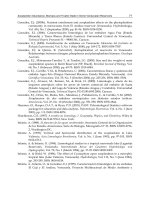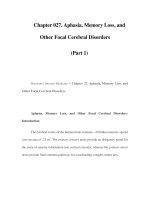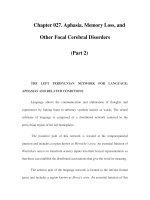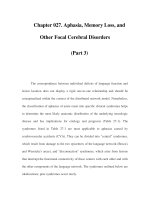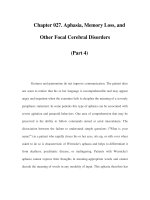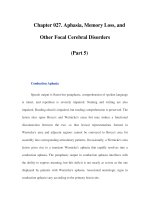Chapter 027. Aphasia, Memory Loss, and Other Focal Cerebral Disorders (Part 5) pot
Bạn đang xem bản rút gọn của tài liệu. Xem và tải ngay bản đầy đủ của tài liệu tại đây (13.16 KB, 5 trang )
Chapter 027. Aphasia, Memory Loss, and
Other Focal Cerebral Disorders
(Part 5)
Conduction Aphasia
Speech output is fluent but paraphasic, comprehension of spoken language
is intact, and repetition is severely impaired. Naming and writing are also
impaired. Reading aloud is impaired, but reading comprehension is preserved. The
lesion sites spare Broca's and Wernicke's areas but may induce a functional
disconnection between the two so that lexical representations formed in
Wernicke's area and adjacent regions cannot be conveyed to Broca's area for
assembly into corresponding articulatory patterns. Occasionally, a Wernicke's area
lesion gives rise to a transient Wernicke's aphasia that rapidly resolves into a
conduction aphasia. The paraphasic output in conduction aphasia interferes with
the ability to express meaning, but this deficit is not nearly as severe as the one
displayed by patients with Wernicke's aphasia. Associated neurologic signs in
conduction aphasia vary according to the primary lesion site.
Nonfluent Transcortical Aphasia (Transcortical Motor Aphasia)
The features are similar to Broca's aphasia, but repetition is intact and
agrammatism may be less pronounced. The neurologic examination may be
otherwise intact, but a right hemiparesis can also exist.
The lesion site disconnects the intact language network from prefrontal
areas of the brain and usually involves the anterior watershed zone between
anterior and middle cerebral artery territories or the supplementary motor cortex in
the territory of the anterior cerebral artery.
Fluent Transcortical Aphasia (Transcortical Sensory Aphasia)
Clinical features are similar to those of Wernicke's aphasia, but repetition is
intact. The lesion site disconnects the intact core of the language network from
other temporoparietal association areas. Associated neurologic findings may
include hemianopia. Cerebrovascular lesions (e.g., infarctions in the posterior
watershed zone) or neoplasms that involve the temporoparietal cortex posterior to
Wernicke's area are the most common causes.
Isolation Aphasia
This rare syndrome represents a combination of the two transcortical
aphasias. Comprehension is severely impaired, and there is no purposeful speech
output. The patient may parrot fragments of heard conversations (echolalia),
indicating that the neural mechanisms for repetition are at least partially intact.
This condition represents the pathologic function of the language network when it
is isolated from other regions of the brain. Broca's and Wernicke's areas tend to be
spared, but there is damage to the surrounding frontal, parietal, and temporal
cortex. Lesions are patchy and can be associated with anoxia, carbon monoxide
poisoning, or complete watershed zone infarctions.
Anomic Aphasia
This form of aphasia may be considered the "minimal dysfunction"
syndrome of the language network. Articulation, comprehension, and repetition
are intact, but confrontation naming, word finding, and spelling are impaired.
Speech is enriched in function words but impoverished in substantive nouns and
verbs denoting specific actions.
Language output is fluent but paraphasic, circumlocutious, and
uninformative. The lesion sites can be anywhere within the left hemisphere
language network, including the middle and inferior temporal gyri. Anomic
aphasia is the single most common language disturbance seen in head trauma,
metabolic encephalopathy, and Alzheimer's disease.
Pure Word Deafness
The most common causes are either bilateral or left-sided middle cerebral
artery strokes affecting the superior temporal gyrus. The net effect of the
underlying lesion is to interrupt the flow of information from the unimodal
auditory association cortex to Wernicke's area. Patients have no difficulty
understanding written language and can express themselves well in spoken or
written language.
They have no difficulty interpreting and reacting to environmental sounds
since primary auditory cortex and subcortical auditory relays are intact. Since
auditory information cannot be conveyed to the language network, however, it
cannot be decoded into lexical representations and the patient reacts to speech as if
it were in an alien tongue that cannot be deciphered.
Patients cannot repeat spoken language but have no difficulty naming
objects. In time, patients with pure word deafness teach themselves lip reading and
may appear to have improved. There may be no additional neurologic findings, but
agitated paranoid reactions are frequent in the acute stages. Cerebrovascular
lesions are the most frequent cause.

